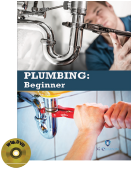Trade and Industrial Education

Plumbing: Beginner combines many different practical and visual skills with knowledge of specialized materials and techniques. Plumbing is the system of pipes, drains, fittings, valves, and fixtures installed for the distribution of potable water for drinking, heating and washing, and waterborne waste removal. This book will introduce the knowledge and skills for those studying and/or working in plumbing or construction field.
About this Book
This book consists of competencies that a person must achieve in installing multiple units of plumbing system with multi-point hot- and cold-water lines for medium-rise buildings. It also includes plumbing repair and maintenance work.
About the Plumbing Industry
Plumbing covers trade areas such as water, sanitary, gas, mechanical services, heating and cooling, industrial wastes, metal roofing, drainage, building services and other specialized areas, e.g. fire services and air-conditioning. The sector has some large enterprises but is dominated by small firms and self-employed tradespeople, with an estimated 90% of plumbing contractor businesses employing between 1 and 50 employees. The workforce is involved in plumbing services ranging from domestic maintenance through to high-rise construction. The demand for plumbers usually depends on the level of activity in the building industry. However, unlike other building trades, downturns in building activity have less effect on plumbers because of the work available in renovation and maintenance. New technologies such as solar hot water, higher efficiency hot water units, and water treatment systems for grey and black water, new high efficiency heating and cooling systems are all being demanded by consumers and require new skills and the ability to offer advice. By far the largest industry area is the service area. This is concerned with the installation, maintenance and replacement of facilities in institutions such as hospitals, laboratories, hotels and schools. The service sector also includes many industrial and manufacturing installations as well as commerce in shops and offices and of course a very large market of domestic plumbing consumers. Typical occupations include:
1. Drainage worker - install, maintain and repair pipes in storm water or sanitation systems and drains, install septic tanks, holding wells, sullage pits and absorption tracks
2. Gasfitter - install, maintain, test and repair gas lines, meters, regulators, units and appliances
3. Plumber - install, maintain and repair pipes and fittings designed to convey hot and cold water
4. Roof plumber - install and fix roofs, flashings, gutters and downpipes
5. Sanitary plumber - install, remove, renew, repair and maintain pipes, including ventilation of those pipes and fittings to receive and convey sewage
6. Mechanical services plumber - install and service heating and cooling systems.
Technology impacts on the sector in various ways. Changes to the type of equipment used by plumbers has seen the introduction of video cameras to inspect for hidden leaks in drainage systems or hydro jets, and high pressure hydraulic pumps connected to steel cables for trench-less sewer line replacement. Additionally, the introduction of new materials such as recycled plastic piping requires up skilling the workforce to learn new methods of handling and installation.